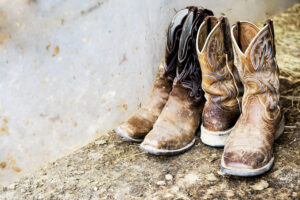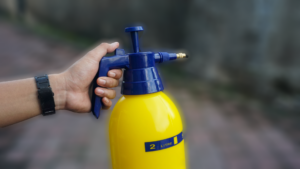Getting the Dirt on Cleaning Versus Disinfecting

We all know raising animals is a dirty job. The piles of mucky boots at the door and the stacks of laundry that seem to grow out of thin air are all evidence of the constant battle for cleanliness in the day-to-day operations of a cattle farm. Although we do our best to keep the dirt where it belongs, are we being mindful of the germs that could be lurking within?
“Germs” or pathogens come in all shapes and sizes, and all can pose risk to the health and wellbeing of both the cattle and the people handling them. These tiny invaders can be transferred around your property in dozens of different ways. This can lead to devastating losses, such as abortion in the cow herd, scouring of calves and even decreased performance of herd sires. It is important to know how to implement best practices to both prevent infections from occurring and eliminate the spread once they are already present.
The first step in developing any best practice protocol is always to ask the question: “What are we trying to accomplish?” When tackling the job of cleaning and/or disinfecting a particular part of a farm, we need to ask a few basic questions.
- Are we cleaning or disinfecting, or both?
- What types of pathogens are we trying to eliminate?
- What products should we use?
- What is the contact time needed for disinfection?
The difference between cleaning and disinfecting
Disinfection products (such as Prevail, Dettol, or Virkon) are chemical compounds designed to destroy specific pathogens. In order for these products to work, the area to be disinfected must be free from organic compounds (such as manure, dirt, feed and bedding) to ensure the chemicals can come into contact with the pathogens themselves and are not inactivated by any organic materials. We accomplish this by cleaning. Without this step, the time and effort spent disinfecting is money down the drain.
Cleaning can further be broken down into three steps:
- Dry cleaning: Physically removing as much of the organic matter as possible prior to applying any detergents or water (e.g., shoveling out the trailer before washing it, or scraping boots before heading to the boot dip).
- Wet cleaning: The process of applying detergent and water. The detergent can chemically break down the biofilm (a thin, slimy film of bacteria that adheres to a surface) and the mechanical action of scrubbing and water spray will whisk away the organic material that remains in the way of proper disinfection. Rinse all cleaner residues from surfaces using clean water at the end of this step.
- Drying: All surfaces should be allowed to dry completely before proceeding to disinfection.

Once your surface is clean and dry, you can proceed to disinfection.
Disinfection can only occur once the surface is clean. There are three main considerations when choosing a disinfection product:
- What pathogens are you dealing with? Are you trying to prevent as many pathogens as possible when you clean out a neighbour’s trailer for use on your farm? Or, have you had an outbreak in your calving barn and you know specifically what pathogen you are targeting? Be careful to choose a product that covers the types of pathogens that may be threatening your herd.
- Mixing instructions: Ensure that you are following the product label and mixing instructions. Not mixing strong enough could lead to incomplete disinfection. Mixing too strong could potentially cause health effects from concentrated chemical exposure. Either mistake is a waste of disinfectant and money.
- What is the contact time to accomplish disinfection? Many disinfectants need upwards of 30 minutes of “contact time” (the amount of time that a chemical must be in contact with a pathogen in order to destroy it). Be sure to double check the recommended contact time on the product label. During this time the surface must be kept wet with the disinfectant, which can be challenging to accomplish, especially with vertical smooth surfaces such as stall walls or trailer walls. Many products or product combinations have taken this obstacle into consideration and will include a foaming action to help the product adhere to surfaces for a longer period of time. Once contact time has been accomplished, most disinfectants will need to be rinsed off and the surface air dried.
which Disinfectant should you use?
Legend: ++ (highly effective), + (effective), +- (limited activity), – (no activity), N (information not available)

The key to good disinfection is certainly cleaning. One can clean without disinfecting, but you cannot disinfect without cleaning. When choosing cleaning and disinfecting products for your farm, make sure you make yourself familiar with the label. Although labels can be daunting it is important to familiarize yourself with the pathogens that the product is effective against, mixing instructions, and the contact time. Just as you would not use an antibiotic without knowing the dose, it is crucial to use these products as directed. When used properly, disinfecting agents can be your first defense against pathogens entering and spreading through your animals, saving you precious time and money.
Le partage ou la réimpression des articles du blog du BCRC est bienvenu et et encouragé. Veuillez mentionner le Conseil de recherche sur les bovins de boucherie, indiquer l’adresse du site web, www.BeefResearch.ca/fr, et nous faire savoir que vous avez choisi de partager l’article en nous envoyant un courriel à l’adresse info@beefresearch.ca.
Vos questions, commentaires et suggestions sont les bienvenus. Contactez-nous directement ou suscitez une discussion publique en publiant vos réflexions ci-dessous.